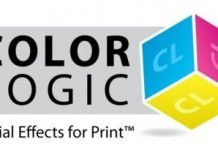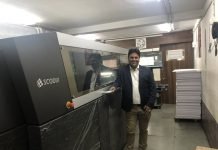
At Sign India Expo 2019 held in Pragati Maidan from 5 to 7 July 2019, Colorjet displayed a wide range of products for the wide format and signage industry. Three wide format inkjet printers were shown including a flatbed UV Colorjet Verve 2513 with 7-color plus varnish with a bed size of 2.5 m x 1.3 m. The printer is basically used for flat and rigid substrates such as almirah doors, wooden doors, glass panels and ceramic tiles. It uses printheads from Ricoh and this machine has more than 100 installations in India.
Colorjet also displayed a printer from its Polo HQ range, an eco-solvent 3.2-meter wide industrial printer. “We observed that solvent machines are really harmful for the environment since the presence of carcinogenic particles in solvents makes them extremely harmful for the workers. However, we launched this Polo HQ printer machine, especially with our Greentech mechanism. With Greentech we make sure that the inks are in compliance with the restriction of hazardous substrates standards (RoHS). The machine is built using Konica Minolta printheads and can print on fabric as well,” says Smarth Bansal, senior product manager at Colorjet India. Since there is a pronounced trend for soft signage using fabrics instead of vinyl substrates, Colorjet was demonstrating the printer on a recyclable fabric at the show. The inks were part of the Greentech mechanism.
Colorjet also displayed its Irisjet Pro wide format printer with environment-friendly inks. Based on Konica Minolta inkjet printheads printing at high speed, it is rated at 1,200 square feet an hour. The machine can be used for flex, outdoor hoardings and banners. Talking about the local signage market, Bansal says, “It is moving more towards fabric and flex is being banned in some states. Inks are becoming more eco-friendly. Customers are graduating towards more eco-friendly solutions. To improve margins, companies want to offer something different and hence the eco-friendly solutions available in the market today come at a slightly higher price. Earlier the demand was for 400 square feet an hour but now it has graduated to 1200 square feet an hour.”
Bansal adds that digital signage is a very different market and would not be able to take over the conventional or static signage market. “A static communication always has a higher value. For example, newspapers, no matter what the circulation is, we are seeing more and more newspaper coming and growing in India. Similarly, static signage will also grow. Digital signage will come but in India there many problems such as lack of reliable electricity and the logistics of more delicate or rigid materials, so it is not that easy to eliminate static signage. The cost associated with digital signage is also high,” says Bansal.
He says that the response to the small exhibition was okay in spite of the fewer exhibitors and visitors. The company is currently focussing on participating in more events overseas such as the recent ITMA textile event in Spain, where it took part in a big way as Platinum sponsors of the ITMA conference in Barcelona.















